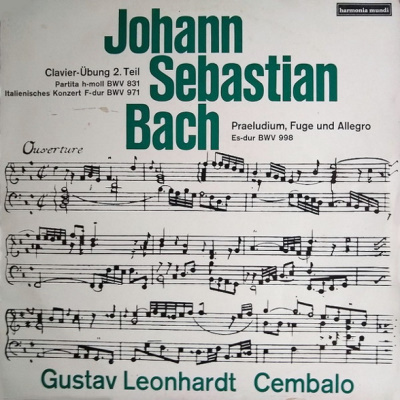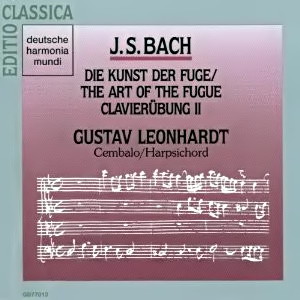 |
|
1 LP -
HM 30 868 - (p) 1968
|
 |
| 2 CDs -
GD 77013 - (c) 1990 |
|
CLAVIERÜBUNG
II (1735)
|
|
|
|
|
|
|
|
| Johann Sebastian
BACH (1685-1750) |
Partita
h-moll, BWV 831 (Ouvertüre nach
französischer Art)
|
|
27' 32" |
A |
|
-
Ouvertüre |
8' 19" |
|
|
|
-
Courante |
2' 33" |
|
|
|
-
Gavotte I/II |
2' 40" |
|
|
|
-
Passepied I/II
|
3' 04" |
|
|
|
-
Sarabande |
2' 39" |
|
|
|
-
Bourrée I/II |
2' 58" |
|
|
|
-
Gigue |
2' 03" |
|
|
|
-
Echo |
3' 16" |
|
|
|
Italienisches
Konzert F-dur, BWV 971 |
|
13' 14" |
B1 |
|
-
Allegro |
4' 20" |
|
|
|
-
Andante |
4' 30" |
|
|
|
-
Presto |
4' 24" |
|
|
|
Praeludium,
Fuge und Allegro Es-dur, BWV
998
*
|
|
10' 36" |
B2 |
|
|
|
|
|
Gustav Leonhardt,
Cembalo
- Martin Skowroneck nach einem Original
von J. D. Dulcken, Antwerpen 1745
- Carl August Gräbner, Dresden 1782 (2
manualiges) * |
|
|
|
|
|
Luogo
e data di registrazione |
|
Cedernsaal, Schloß
Kirchheim (Germany)
- 3 novembre 1967 (BWV 831)
- settembre 1965 (BWV 971 &
998)
|
|
|
Registrazione: live
/ studio |
|
studio |
|
|
Recording
Supervision |
|
Dr. Alfred Krings
|
|
|
Engineer |
|
Hubert Kübler
|
|
|
Prima Edizione LP |
|
Harmonia Mundi | HM
30 868 | 1 LP - durata 51' 20" |
(p) 1968
|
|
|
Edizione CD |
|
Deutsche Harmonia
Mundi | LC 0761 | GD 77013 | 2 CDs
- durata 65' 16" - 66' 35" | (c)
1990 | ADD
|
|
|
Cover Art
|
|
-
|
|
|
Note |
|
-
|
|
|
|
|
The first part
of the Clavierübung
with six partitas was
published by Johann
Sebastian Bach himself in
1731. This first collection
already began to unfold an
entire panorama of the art
of the suite and of
pianistic problems. But the
series was magnificently
expanded in 1735 with a
second part containing the
Italian concerto and a
partita in B minor, a third
part containing the
so-called "organ mass" and
four duets, and finally the
impressive late work, the
Goldberg Variations, which
comprise the fourth part.
Bach's intention, as stated
in the title of the second
part, is explicit:
"Part
Two at the Clavier
Exercises Consisting
of a Concerto according to
the Italian Taste and an
Overture in the French
Manner, for a Harpsichord
with two Manuals.
Dedicated
to the Appreciative, tor
the Pleasure of Spirit. Composed
by J. S. Bach".
In
both works Bach makes the
Italian and French
orchestral styles
serviceable tor the
harpsichord. A piece showing
Italian origins, which
through its three-movement
structure is distinctly
separate irom the older type
of church sonata, it makes a
virtuoso instrument out of
the harpsichord. The style
of Vivaldi‘s violin art and
the contrast between solo
and orchestra are just as
equally combined with Bach's
personal harpsichord
technique, as the widely
extended melody of the
Andante with its wandering
coloratura is modelled after
the free style of southern
singing.
The mastery of an orchestral
style becomes even more
evident in the Partita in B
minor. The model of Lully,
who included five-part dance
movements in his ballets and
operas and who with the
introductory music ot these
works created the conception
of the French overture,
continued to be felt in
France even up to Bach's
day. The name of the
introductory overture, with
its weighty, sharply dotted
rhythms of the beginning
Grave and with its fugally
treated, lively second
section, had frequently
given the name "overture" to
entire suites since the
seventeenth century already.
The lack of the Allemande, a
pure keyboard form,
indicates clearly that Bach
worked from the notion of an
orchestral work for
harpsichord. The traditional
movements Courantc,
Sarabande and Gigue are
complemented by two
Gavottes, two Passepieds
which precede the Sarabande,
and two Bourrées which
follow it as cheerful
interlude.
Whereas Bach still made
reference to the Italian
correnta on several
occasions in the partitas of
the first part of the Clavierübung,
the Courante from the
B-minor Partita demonstrates
how the change of metre
sways between 3/2 and 6/4.
Marpurg described this
rhythm in his critical
correspondence concerning
music with these words: "The
actual metre of the
courantes in the French
style, although belonging to
the weighty 3/2 time,
borrows, according to the
external form at different
places, much from the 6/4
time. The only difference is
that these 6/4 passages must
be played in the regular 3/2
time. The decesed
choir-master Bach has left
behind enough genuine
examples of this some
courante metre".
A musical finale follows the
obbllgato gigue of the
partita, similar to Bach's
use of it in connexion with
the badinerie in his suite
for orchestra in B minor.
The virtuoso piece with its
dance-like vitality has the
title "Echo". The imitations
are, however, in no way
obtrusive, but rather always
incorporated succinctly into
this skilfully treated
section.
Numerous distinctions can be
noted in the two works of
Part II of the Clavierübung.
The general sound of the
Italian concerto, and
especially that of the outer
movements, appears sharper
and brighter through the
higher register and the
particular stamp of the
musical figures. Such
contrasts also demand, of
course, a diversified manner
of playing. In the Italian
concerto, this develops out
of the driving but
nonetheless even flow of
music. In the Partita, to
the contrary, all those
nuances of rhythm and motion
are noticeable which belong
to an art inspired from
France. The music of two
countries is mirrored in the
production of a German
composer, who demonstrates
amazingly how great art
extends beyond lands and
times.
A work appears on our
recording which may serve as
a small supplement to the
second part of the Clavierübung
and whirh has come down to
us in a manuscript froin
Johann Sebastian’s hand from
the remaining papers at Carl
Philipp Emanuel Bach. The
instrumental designation
"pour la Luthe ò Cembal"
precedes the three movements
Prelude, Fugue and Allegro.
Bach's knowledge of the lute
was deepened through the
distinguished lutenist
Sülvius Weiß, who was active
at the Dresden court and who
could provide new impulses
with his own significant
compositions at a time when
this beloved instrument of
the sixteenth and
seventeenth centuries was
practically no longer
played. Our recording with
harpsichord achieves special
charm through an original
instrument by Carl August
Gräbner (Dresden, 1782 from
the collection of
instruments at the
Germanisches Nationalmuseum
in Nuremberg.
|
  |
|
|